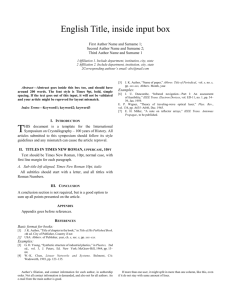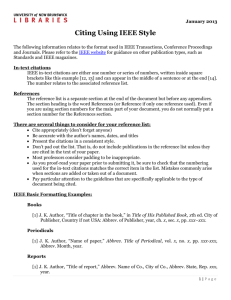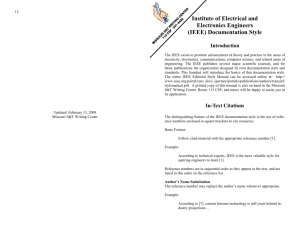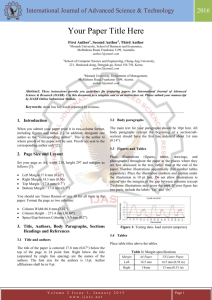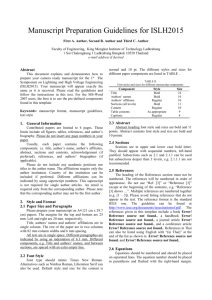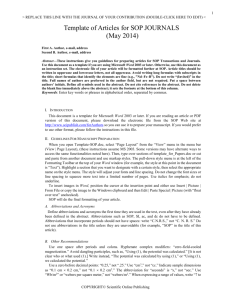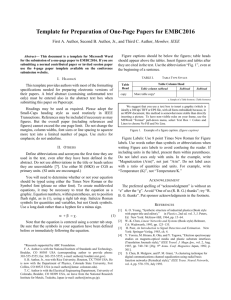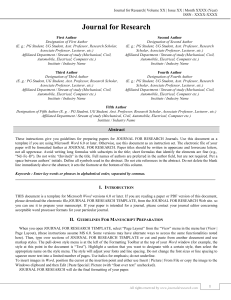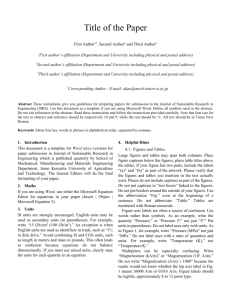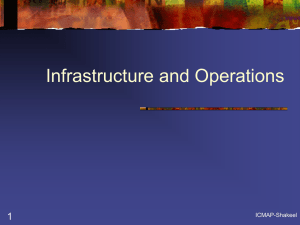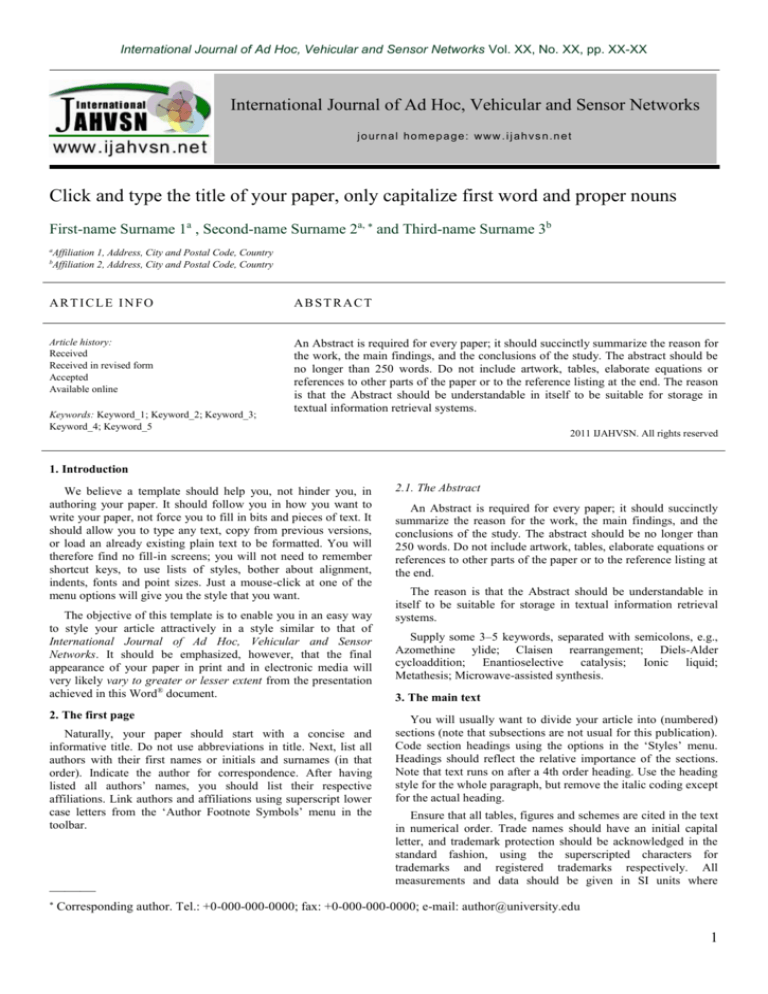
International Journal of Ad Hoc, Vehicular and Sensor Networks Vol. XX, No. XX, pp. XX-XX
International Journal of Ad Hoc, Vehicular and Sensor Networks
journal homepage: www.ijahvsn.net
Click and type the title of your paper, only capitalize first word and proper nouns
First-name Surname 1a , Second-name Surname 2a, and Third-name Surname 3b
a
Affiliation 1, Address, City and Postal Code, Country
Affiliation 2, Address, City and Postal Code, Country
b
ARTICLE INFO
ABSTRACT
Article history:
Received
Received in revised form
Accepted
Available online
An Abstract is required for every paper; it should succinctly summarize the reason for
the work, the main findings, and the conclusions of the study. The abstract should be
no longer than 250 words. Do not include artwork, tables, elaborate equations or
references to other parts of the paper or to the reference listing at the end. The reason
is that the Abstract should be understandable in itself to be suitable for storage in
textual information retrieval systems.
Keywords: Keyword_1; Keyword_2; Keyword_3;
Keyword_4; Keyword_5
2011 IJAHVSN. All rights reserved
1. Introduction
We believe a template should help you, not hinder you, in
authoring your paper. It should follow you in how you want to
write your paper, not force you to fill in bits and pieces of text. It
should allow you to type any text, copy from previous versions,
or load an already existing plain text to be formatted. You will
therefore find no fill-in screens; you will not need to remember
shortcut keys, to use lists of styles, bother about alignment,
indents, fonts and point sizes. Just a mouse-click at one of the
menu options will give you the style that you want.
The objective of this template is to enable you in an easy way
to style your article attractively in a style similar to that of
International Journal of Ad Hoc, Vehicular and Sensor
Networks. It should be emphasized, however, that the final
appearance of your paper in print and in electronic media will
very likely vary to greater or lesser extent from the presentation
achieved in this Word® document.
2. The first page
Naturally, your paper should start with a concise and
informative title. Do not use abbreviations in title. Next, list all
authors with their first names or initials and surnames (in that
order). Indicate the author for correspondence. After having
listed all authors’ names, you should list their respective
affiliations. Link authors and affiliations using superscript lower
case letters from the ‘Author Footnote Symbols’ menu in the
toolbar.
———
2.1. The Abstract
An Abstract is required for every paper; it should succinctly
summarize the reason for the work, the main findings, and the
conclusions of the study. The abstract should be no longer than
250 words. Do not include artwork, tables, elaborate equations or
references to other parts of the paper or to the reference listing at
the end.
The reason is that the Abstract should be understandable in
itself to be suitable for storage in textual information retrieval
systems.
Supply some 3–5 keywords, separated with semicolons, e.g.,
Azomethine ylide; Claisen rearrangement; Diels-Alder
cycloaddition; Enantioselective catalysis; Ionic liquid;
Metathesis; Microwave-assisted synthesis.
3. The main text
You will usually want to divide your article into (numbered)
sections (note that subsections are not usual for this publication).
Code section headings using the options in the ‘Styles’ menu.
Headings should reflect the relative importance of the sections.
Note that text runs on after a 4th order heading. Use the heading
style for the whole paragraph, but remove the italic coding except
for the actual heading.
Ensure that all tables, figures and schemes are cited in the text
in numerical order. Trade names should have an initial capital
letter, and trademark protection should be acknowledged in the
standard fashion, using the superscripted characters for
trademarks and registered trademarks respectively. All
measurements and data should be given in SI units where
Corresponding author. Tel.: +0-000-000-0000; fax: +0-000-000-0000; e-mail: author@university.edu
1
International Journal of Ad Hoc, Vehicular and Sensor Networks Vol. XX, No. XX, pp. XX-XX
possible, or other internationally accepted units. Abbreviations
should be used consistently throughout the text, and all
nonstandard abbreviations should be defined on first usage.
Authors are requested to draw attention to hazardous materials or
procedures by adding the word CAUTION followed by a brief
descriptive phrase and literature references if appropriate. The
experimental information should be as concise as possible, while
containing all the information necessary to guarantee
reproducibility.
Figure 1. (a) Fairness index, (b) Average Fairness Index
Table 1. Table, version 1
Parameter
Value
Parameter
Value
Slot time
20 μs
Slot time
20 μs
ACK size
20 bytes
ACK size
20 bytes
RTS size
25 bytes
RTS size
25 bytes
CTS size
20 bytes
CTS size
20 bytes
Data packet size
1000 bytes
Data packet size
1000 bytes
DIFS interval
40 μs
DIFS interval
40 μs
SIFS interval
10 μs
SIFS interval
10 μs
CWmin
31
CWmin
31
CWmax
1023
CWmax
1023
Bandwidth
2 Mbps
Bandwidth
2 Mbps
Transport protocol
UDP
Transport protocol
UDP
3.1. Tables, figures and schemes
All citations of figure and tables in text must be in numerical
order. Citations to figures in text always carry the word
“Figure.”, “Table.” followed by the figure/table number.
You can choose to display figure/table in one column (20 pica
wide; see Table 1, Figure 1) or across the page (42 pica wide; see
Table 2, Figure 2). Remember that we will always also need
high-resolution versions of your figures for printing in (i.e. TIFF
or EPS) format.
Table 2. Table, version 2
Parameter
Value
Slot time
20 μs
ACK size
20 bytes
RTS size
25 bytes
CTS size
20 bytes
Data packet size
1000 bytes
DIFS interval
40 μs
Bandwidth
2 Mbps
Transport protocol
UDP
2
International Journal of Ad Hoc, Vehicular and Sensor Networks Vol. XX, No. XX, pp. XX-XX
References
The journal uses the IEEE Template for references formatting.
References in the text should be indicated by Arabic numerals
that run consecutively through the paper and appear inside
punctuation.
Figure 2. Overload on GV and IV vehicles
3.2. Lists
For tabular summations that do not deserve to be presented as
a table, lists are often used. Lists may be either numbered or
bulleted. Below you see examples of both.
Authors should ensure that all references are cited in the text
and vice versa. Authors are expected to check the original source
reference for accuracy. See examples shown in the References
section. In text, refer simply to the reference number. Do not use
“Ref.”, “reference” or “Reference [3] shows ... .” use as
demonstrated in [3]; according to [4] and [6-9]. Please do not use
automatic endnotes in Word, rather, type the reference list at the
end of the paper using the “References” style. The authors
encourage using the “EndNote” software to format and insert the
references into the paper (http://endnote.com/). IEEE EndNote
template
can
be
downloaded
from
(http://endnote.com/downloads/template/ieee).
1.
The first entry in the list
Acknowledgments
2.
The second entry
Acknowledgments should be inserted at the end of the paper,
before the references. When citing names within the
Acknowledgment, do not use Mr., Mrs., Ms., or Miss (list first
initial and last name only). Use the Dr. or Prof. title with each
name separately; do not use plural Drs. or Profs. with lists of
names. All acknowledgment of financial support must be in the
Acknowledgment section
2.1. A subentry
3.
The last entry
A bulleted list item
Another one
REFERENCES
Basic format for books:
You can use the Bullets and Numbering options in the
‘Formatting’ toolbar of Word® to create lists. Note that you
should first block the whole list. A sublisting is coded using the
‘Increase Indent’ (go to a sublevel of numbering) and ‘Decrease
Indent’ (go to a higher level of numbering) buttons.
3.3. Equations
You can type your equations and use the symbols in the
Word® equation editor or in MathType™. Using the ‘Insert
Equation’ option, you can create equations in the Word ® equation
editor, or if the MathType™ equation editor is installed on your
computer.
(theor) cos
[2]
(1)
J. K. Author, “Title of chapter in the book,” in Title of His Published
Book, xth ed. City of Publisher, Country if not
USA: Abbrev. of Publisher, year, ch. x, sec. x, pp. xxx–xxx.
Examples:
[3]
[4]
Equations within a paper are numbered consecutively from the
beginning of the paper to the end. In that case the number should
appear at the right margin. Certain types of material in displayed
equations are automatically italic. Some simple general rules
apply. All variables are italic. (e.g., x, y, n). Function names and
abbreviations are Roman (sin, cos, sinc, sinh), as are units or unit
abbreviations (e.g., deg, Hz,) complete words (e.g., in, out), and
abbreviations of words (e.g., max, min), or acronyms (e.g., SNR).
Single letter superscripts and subscripts may be italic even if they
are abbreviations, unless this leads to inconsistency between
italic and roman characters for similar types of subscripts.
(empir,1.388Å) (theor,1.388Å)
[1]
G. O. Young, “Synthetic structure of industrial plastics,” in Plastics,
2nd ed., vol. 3, J. Peters, Ed. New York: McGraw-Hill, 1964,
pp. 15–64.
W.-K. Chen, Linear Networks and Systems. Belmont, CA:
Wadsworth, 1993, pp. 123–135.
Basic format for periodicals:
[5]
J. K. Author, “Name of paper,” Abbrev. Title of Periodical, vol. x, no.
x, pp. xxx-xxx, Abbrev. Month, year.
Examples:
[6]
[7]
[8]
J. U. Duncombe, “Infrared navigation—Part I: An assessment
of feasibility,” IEEE Trans. Electron Devices, vol. ED-11, no. 1, pp.
34–39, Jan. 1959.
E. P. Wigner, “Theory of traveling-wave optical laser,” Phys. Rev.,
vol. 134, pp. A635–A646, Dec. 1965.
E. H. Miller, “A note on reflector arrays,” IEEE Trans. Antennas
Propagat., to be published.
Basic format for reports:
[9]
J. K. Author, “Title of report,” Abbrev. Name of Co., City of Co.,
Abbrev. State, Rep. xxx, year.
Examples:
[10] E. E. Reber, R. L. Michell, and C. J. Carter, “Oxygen absorption in the
earth’s atmosphere,” Aerospace Corp., Los Angeles, CA, Tech. Rep.
TR-0200 (4230-46)-3, Nov. 1988.
[11] J. H. Davis and J. R. Cogdell, “Calibration program for the 16-foot
antenna,” Elect. Eng. Res. Lab., Univ. Texas, Austin, Tech. Memo.
NGL-006-69-3, Nov. 15, 1987.
Basic format for handbooks:
[12] Name of Manual/Handbook, x ed., Abbrev. Name of Co., City of Co.,
Abbrev. State, year, pp. xxx-xxx.
Examples:
3
International Journal of Ad Hoc, Vehicular and Sensor Networks Vol. XX, No. XX, pp. XX-XX
[13] Transmission Systems for Communications, 3rd ed., Western Electric
Co., Winston-Salem, NC, 1985, pp. 44–60.
[14] Motorola Semiconductor Data Manual, Motorola Semiconductor
Products Inc., Phoenix, AZ, 1989.
[30] G. Brandli and M. Dick, “Alternating current fed power supply,”
U.S. Patent 4 084 217, Nov. 4, 1978.
Basic format for theses (M.S.) and dissertations (Ph.D.):
[15] Author. (year, month day). Title. (edition) [Type of medium].
volume (issue). Available: site/path/file
[31] J. K. Author, “Title of thesis,” M.S. thesis, Abbrev. Dept., Abbrev.
Univ., City of Univ., Abbrev. State, year.
[32] J. K. Author, “Title of dissertation,” Ph.D. dissertation, Abbrev. Dept.,
Abbrev. Univ., City of Univ., Abbrev. State, year.
Example:
Examples:
[16] J. Jones. (1991, May 10). Networks. (2nd ed.) [Online]. Available:
http://www.atm.com
[33] J. O. Williams, “Narrow-band analyzer,” Ph.D. dissertation, Dept. Elect.
Eng., Harvard Univ., Cambridge, MA, 1993.
[34] N. Kawasaki, “Parametric study of thermal and chemical
nonequilibrium nozzle flow,” M.S. thesis, Dept. Electron. Eng., Osaka
Univ., Osaka, Japan, 1993.
Basic format for books (when available online):
Basic format for journals (when available online):
[17] Author. (year, month). Title. Journal. [Type of medium]. volume
(issue), pages. Available: site/path/file
Example:
[18] R. J. Vidmar. (1992, Aug.). On the use of atmospheric plasmas as
electromagnetic reflectors. IEEE Trans. Plasma Sci. [Online].
21(3),
pp.
876–880.
Available:
http://www.halcyon.com/pub/journals/21ps03-vidmar
Basic format for papers presented at conferences (when available
online):
[19] Author. (year, month). Title. Presented at Conference title. [Type
of Medium]. Available: site/path/file
Example:
[20] PROCESS Corp., MA. Intranets: Internet technologies deployed
behind the firewall for corporate productivity. Presented at
INET96
Annual
Meeting.
[Online].
Available:
http://home.process.com/Intranets/wp2.htp
Basic format for the most common types of unpublished references:
[35] J. K. Author, private communication, Abbrev. Month, year.
[36] J. K. Author, “Title of paper,” unpublished.
[37] J. K. Author, “Title of paper,” to be published.
Examples:
[38] A. Harrison, private communication, May 1995.
[39] B. Smith, “An approach to graphs of linear forms,” unpublished.
[40] A. Brahms, “Representation error for real numbers in binary computer
arithmetic,” IEEE Computer Group Repository, Paper R-67-85.
Basic format for standards:
[41] Title of Standard, Standard number, date.
Examples:
[42] IEEE Criteria for Class IE Electric Systems, IEEE Standard 308, 1969.
[43] Letter Symbols for Quantities, ANSI Standard Y10.5-1968.
Basic format for reports and handbooks (when available online):
[21] Author. (year, month). Title. Comp an y . C ity, State or
Country. [Type of Medium].Available: site/path/file
Example:
[22]
S. L. Tall een . (199 6 , Ap r . ). Th e In t r an et Archi te c tu r e : M a n a g i n g i n f o r m a t i o n i n t h e n e w paradigm.
Amdahl
Corp.,
CA.
[Online].
Available:
http://www.amdahl.com/doc/products/bsg/intra/infra/html
Basic format for computer programs and electronic documents
(when available online): ISO recommends that capitalization follow
the accepted practice for the language or script in which the
information is given.
Example:
[23] A. Harriman. (1993, June). Compendium of genealogical
software.
Humanist.
[Online].
Available
e-mail:
HUMANIST@NYVM.ORG Message: get GENEALOGY REPORT
Basic format for patents (when available online):
[24] Name of the invention, by inventor’s name. (year, month day). Patent
Number [Type of medium]. Available: site/path/file
Example:
[25] Musical toothbrush with adjustable neck and mirror, by L.M.R. Brooks.
(1992, May 19). Patent D 326 189
[Online]. Available: NEXIS Library: LEXPAT File: DESIGN
Basic format for conference proceedings (published):
[26] J. K. Author, “Title of paper,” in Abbreviated Name of Conf., City of
Conf., Abbrev. State (if given), year, pp. xxxxxx.
Example:
[27] D. B. Payne and J. R. Stern, “Wavelength-switched pas- sively coupled
single-mode optical network,” in Proc. IOOC-ECOC, 1985,
pp. 585–590.
Example for papers presented at conferences (unpublished):
[28] D. Ebehard and E. Voges, “Digital single sideband detection for
interferometric sensors,” presented at the 2nd Int. Conf. Optical Fiber
Sensors, Stuttgart, Germany, Jan. 2-5, 1984.
Basic format for patents:
[29] J. K. Author, “Title of patent,” U.S. Patent x xxx xxx, Abbrev. Month,
day, year.
Example:
4

